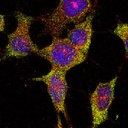Central auditory plasticity after carboplatin-induced unilateral inner ear damage in the chinchilla: up-regulation of GAP-43 in the ventral cochlear nucleus.
Keywords
Abstract
Inner ear damage may lead to structural changes in the central auditory system. In rat and chinchilla, cochlear ablation and noise trauma result in fiber growth and synaptogenesis in the ventral cochlear nucleus (VCN). In this study, we documented the relationship between carboplatin-induced hair cell degeneration and VCN plasticity in the chinchilla. Unilateral application of carboplatin (5mg/ml) on the round window membrane resulted in massive hair cell loss. Outer hair cell degeneration showed a pronounced basal-to-apical gradient while inner hair cell loss was more equally distributed throughout the cochlea. Expression of the growth associated protein GAP-43, a well-established marker for synaptic plasticity, was up-regulated in the ipsilateral VCN at 15 and 31 days post-carboplatin, but not at 3 and 7 days. In contrast, the dorsal cochlear nucleus showed only little change. In VCN, the high-frequency area dorsally showed slightly yet significantly stronger GAP-43 up-regulation than the low-frequency area ventrally, possibly reflecting the high-to-low frequency gradient of hair cell degeneration. Synaptic modification or formation of new synapses may be a homeostatic process to re-adjust mismatched inputs from two ears. Alternatively, massive fiber growth may represent a deleterious process causing central hyperactivity that leads to loudness recruitment or tinnitus.


